Digital Transformation: Malaysia on the World Digital Economy Stage
Sector Digital Team
The objective of the Sector Digital Team was established to strengthen digitalization initiatives based on the Whole of Government (WoG) concept through the Government Technology (GovTech) approach adapted from the World Bank’s GovTech.
The authority for the establishment of the team was through the Government Cluster Modernization and MyDigital Committee Meeting Number 1 of 2024 on 27 November 2024, chaired by YBhg. Tan Sri Chief Secretary to the Government.
The medium for implementation, monitoring and discussion of emerging matters is through the Government Digital Initiative Sector Coordination Meeting. The governance and membership of the Sector Digital Team is as shown in the diagram below.

The Sector Heads were appointed through the Sector Head Determination Meeting for the Government’s Digital Initiative on 6 January 2025, chaired by YBhg. Tan Sri Director General of Public Services. The full list of Sector Heads is as per the table below.
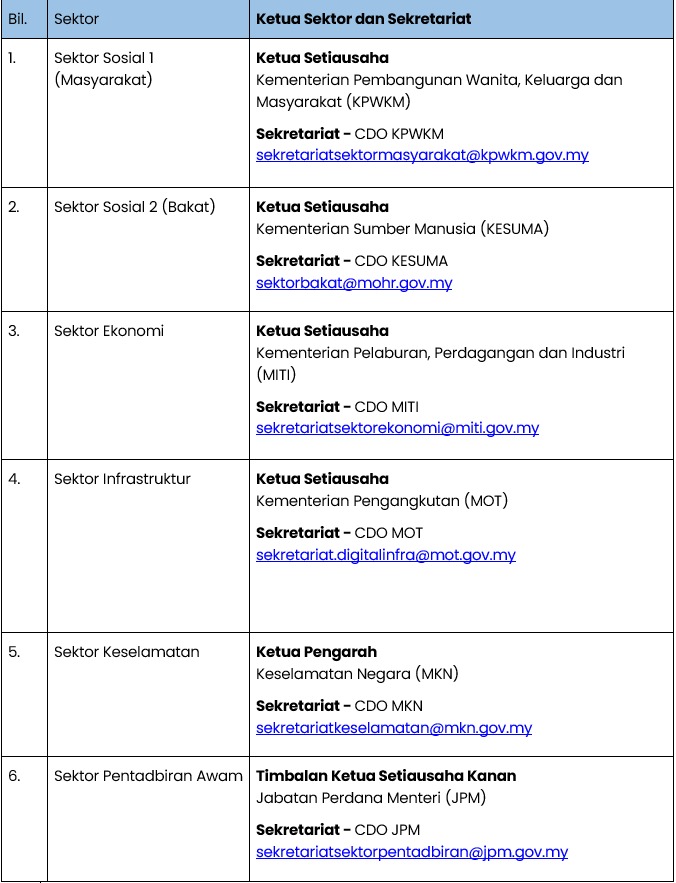
The Terms of Reference set out are to carry out the functions and roles of the Sector Digital Team as follows:
I. Leading sector digitalization through coordination and monitoring of government digital initiatives.
II. Planning for integrated digitalization of services through a whole of government approach Government – WoG) to avoid duplication of digital initiatives.
III. Ensure that government service designs are developed based on Design Guidelines Government Digital Services (Service Design).
IV. Ensure the implementation of data sharing across public sector agencies to realize data-driven digital service delivery.
V. Optimize resources and costs of digital initiatives through the use of centralized digital platforms and infrastructure in ICT/digital projects.
VI. Improve service efficiency and government administrative management with greater integrity.
VII. Develop the digital capabilities and skills of all officers in the agency.
Digitalization of Services based on service clusters according to sectors as follows:
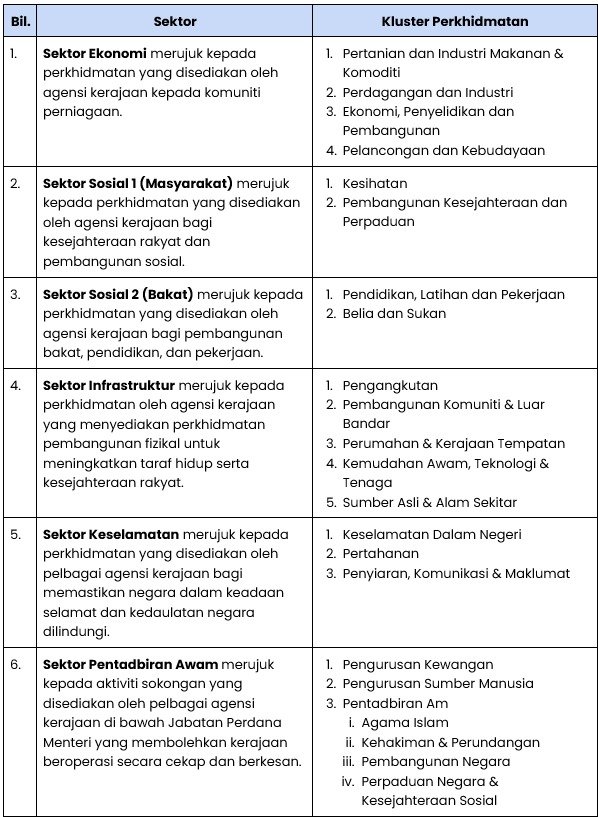
To submit a Public Sector Digitization Initiative Proposal Paper for ICT projects, ministries/agencies can refer to the agency’s service functions by sector based on the following description:
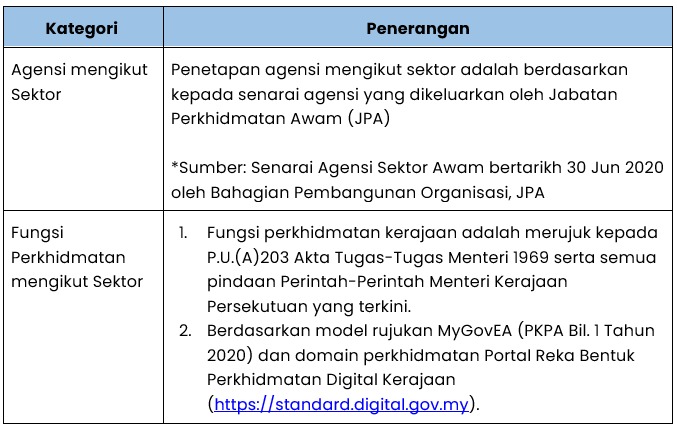
Scenario 1 : Agencies and service functions under the same sector
The Ministry of Trade, Investment and Industry (MITI) is an agency under the Economic Sector. Meanwhile, the digitalization initiative in Business Grant Management led by MITI is also an initiative under the Economic Sector.
Scenario 2 : Service functions under the same agency are involved in different sectors
The Ministry of Finance’s tax-related service functions are under the Economic Sector. While the financial management and accounting service functions are under the Public Administration Sector.
Scenario 3 : Federal agency service functions that have interactions (data sharing and seamless services) with states
The Islamic family management service function involving agencies under the Prime Minister’s Department and state agencies is an initiative of the Public Administration Sector. To implement digitalization involving state government powers, JAKIM is the leader of this initiative under the Public Administration Sector.
Scenario 4 : Service functions under the same agency are involved in various sectors of the Local Government Department, KPKT which coordinates the service functions of Local Authorities is an agency under the Infrastructure Sector.
a. Service functions related to financial management and accounts in local authorities are under the Public Administration Sector.
b. Service functions related to licensing and business control are under the Economic Sector.
c. function Services related to landscape development and management are under the Infrastructure Sector.
d. The function of health and environmental control services is under Social Sector 1 (Community).
e. The function of population security control services is under the Security Sector.
Determination of service domains based on operations and services provided by the organization to recipients or target groups. The main services of ministries/agencies can be grouped into several common domains covering services provided by central agencies, federal agencies, states and local governments. The selection of service domains can be guided by the Service Categories (Business Categories) in Public Services, as contained in the Business Reference Model (BRM MyGovEA) guidelines. This approach encourages agencies/ministries to collaborate as a unit based on the same service domain in line with the Malaysian Digital Government initiatives and strategies. In addition, this approach can also enhance new ways of operating services offered by the government.
Services are mapped to four target groups, namely services to the people (Government to Citizen – G2C), to the business community (Government to Business – G2B), between government agencies (Government to Government-G2G) and to civil servants (Government to Employee – G2E).
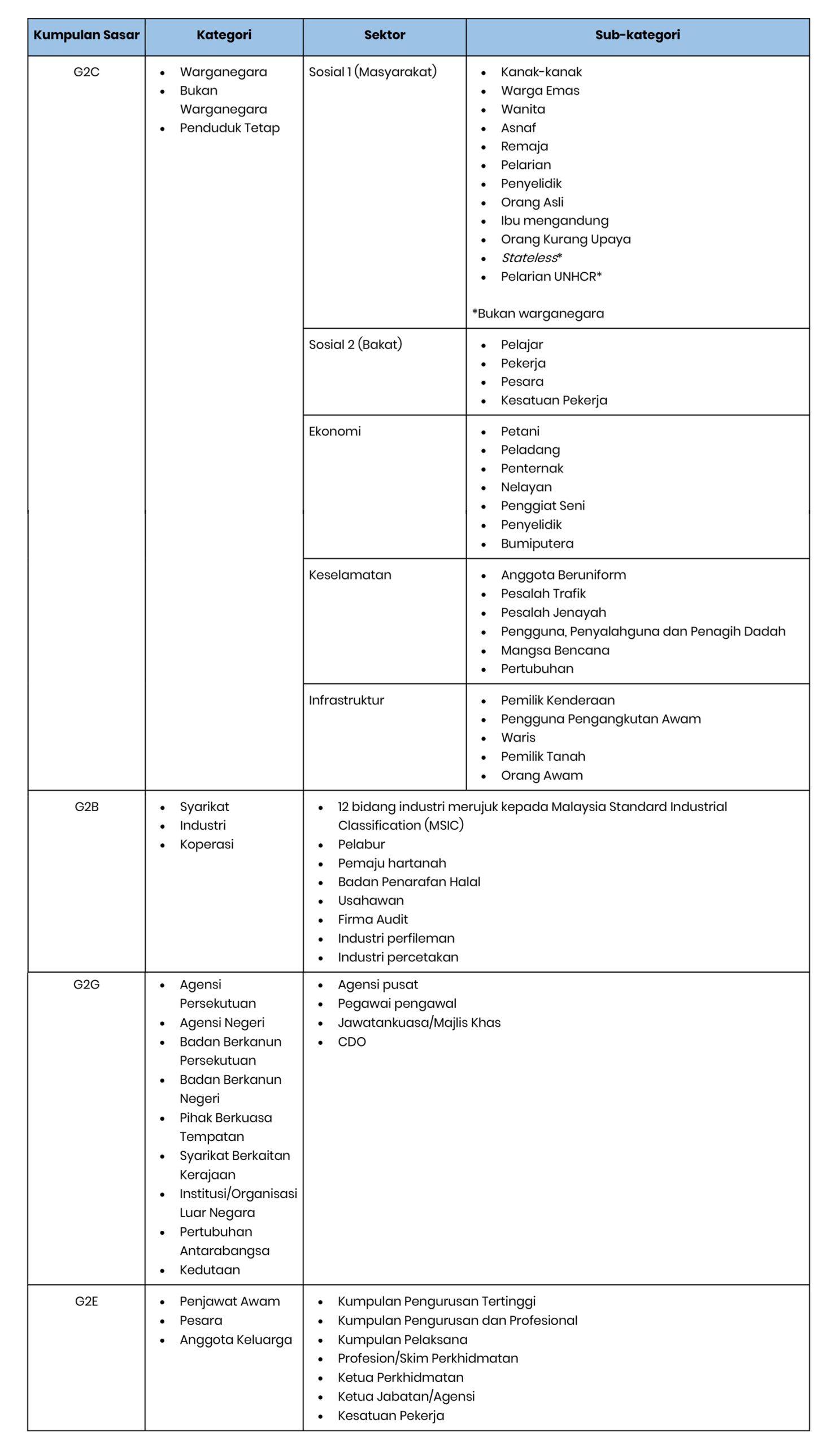
The lifecycle of government services from start to finish is designed by identifying events that are touch points. to the people. The service life cycle is based on four main categories of target groups, namely focusing on the people, the business community, government agencies, and civil servants. An overview of the life cycle determination according to target groups is as shown in the diagram below.
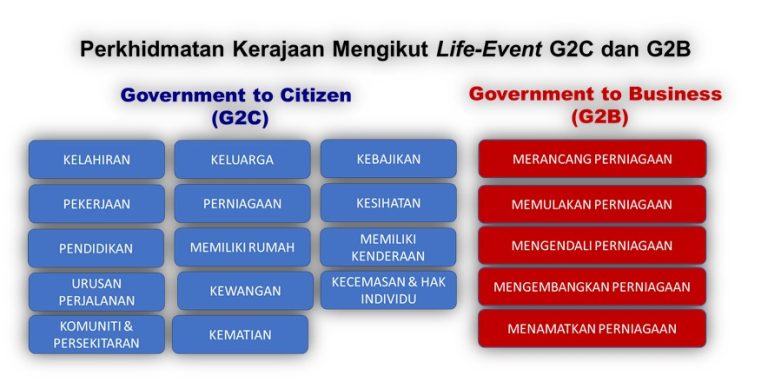
The WoG approach is important to ensure that digitalization is not done in silos , but is coordinated to enable data sharing and integrated service delivery across sectors.
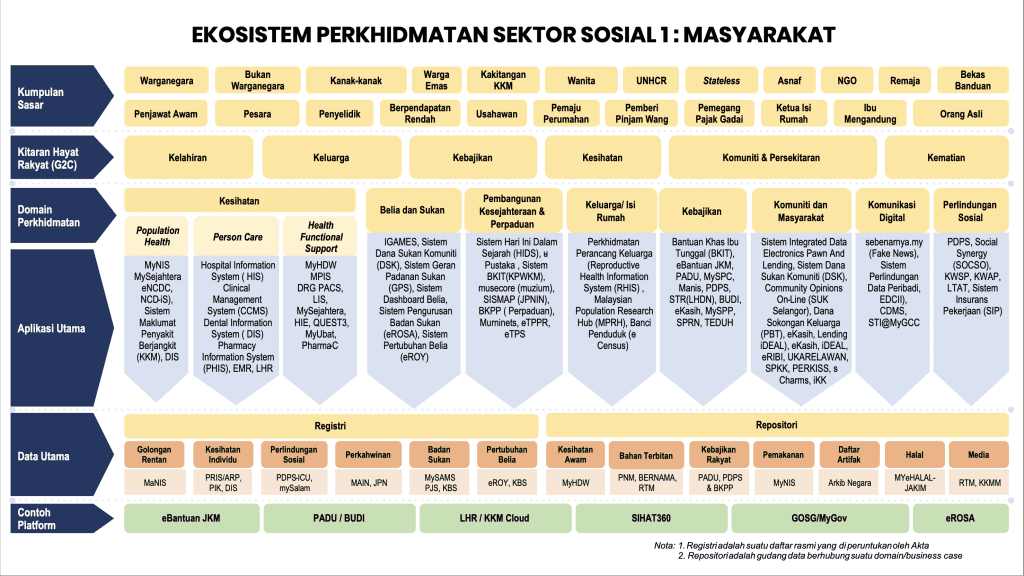
Overview of Social Sector (Society) Digitalization, showcasing digital services aimed at people’s well-being and social development. It highlights platforms and systems related to healthcare (MySejahtera, EMR), social assistance (eBantuan JKM), and community engagement. WoG services enable a more holistic approach to social services, allowing agencies to share data and coordinate support for people across different needs and life events. This can lead to more effective and people-centred service delivery.
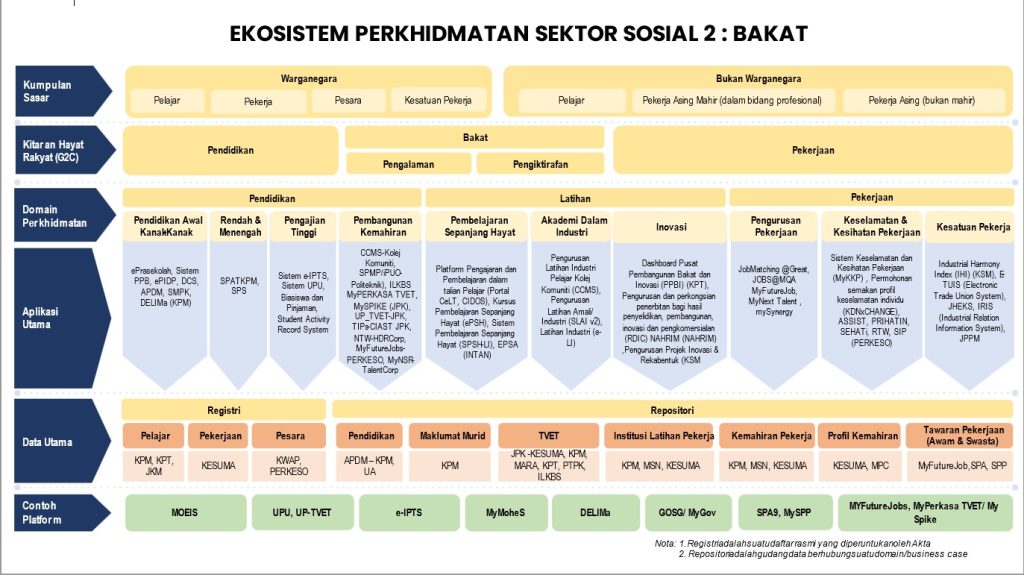
The Digitalization of the Social Sector (Talent) Overview, covers talent management, education, and employment. It explains the digital platform for learning (DELIMa), skills development, and job matching (MyFutureJobs). WoG services facilitate better coordination between educational institutions, training providers, and employers, ensuring a more aligned and efficient talent ecosystem. This can improve workforce readiness and career development opportunities.
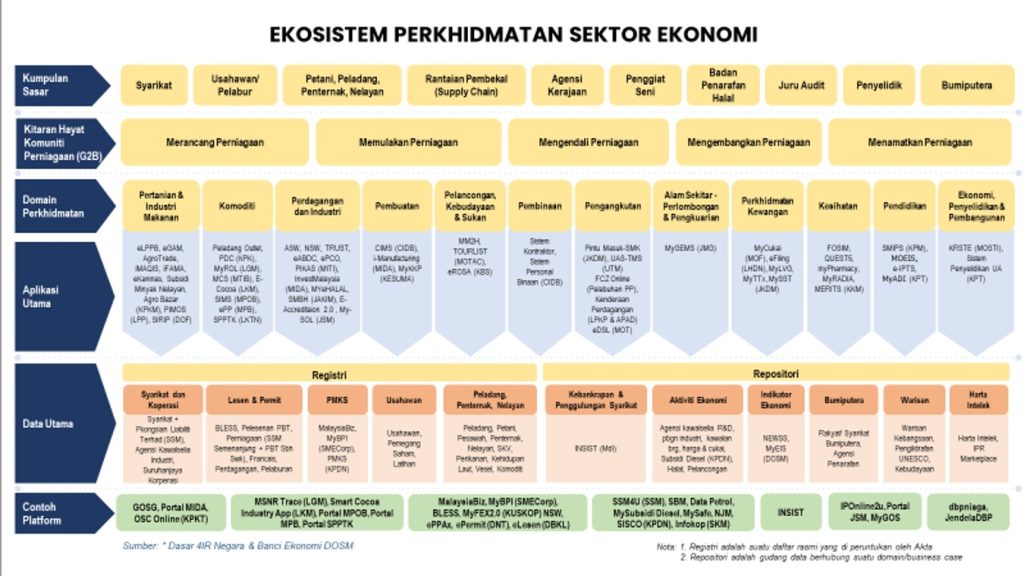
The Economic Sector Digitization Overview details the various services provided by government agencies to the business community. The use of digital platforms (e.g., MalaysiaBiz, EzBIZ) and data repositories to support business activities. WoG services are essential to create a seamless customer experience scenario for businesses, enabling them to interact with different agencies through integrated and non-discrete systems. Direct benefits include greater efficiency in business registration, permit applications, and other regulatory interactions.

Overview of the Digitalization of the Security Sector, focusing on digital systems for law enforcement (e-Justice), immigration (MyIMMs) and disaster management. WoG services are essential for effective information sharing and coordination between security agencies, improving security public and national security.
Three initiatives have been identified under the security sector, namely Pre, During and Post-Disaster Management Preparedness, Improving Integrated Border Control Security and Maintaining Public Safety and Order.
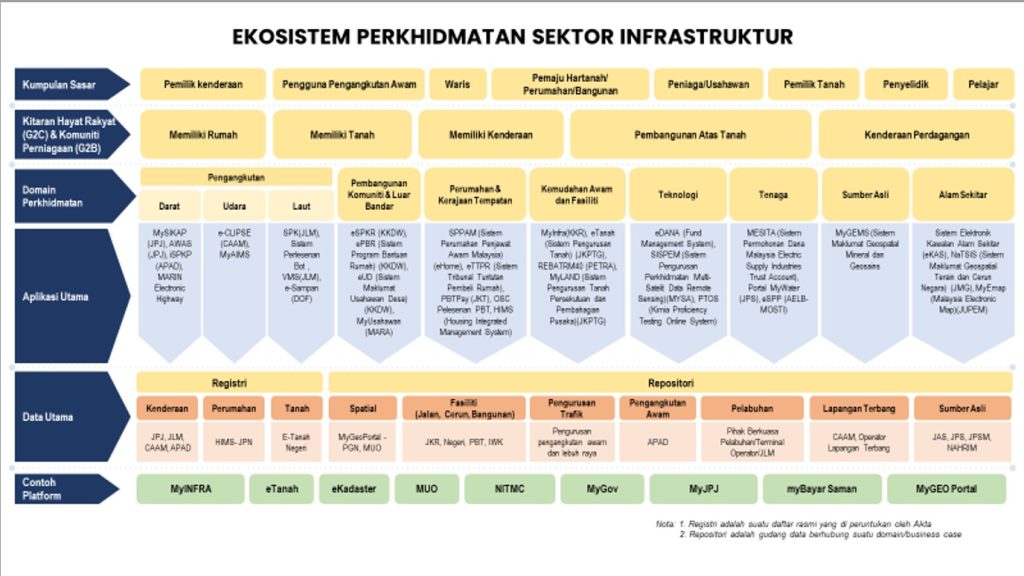
The Infrastructure Sector Digitalization Overview focuses on services by government agencies that provide physical development services to improve the standard of living and well-being of the people. WoG services are essential for integrating infrastructure planning and management across various levels of government and agencies, leading to more efficient development and service delivery.
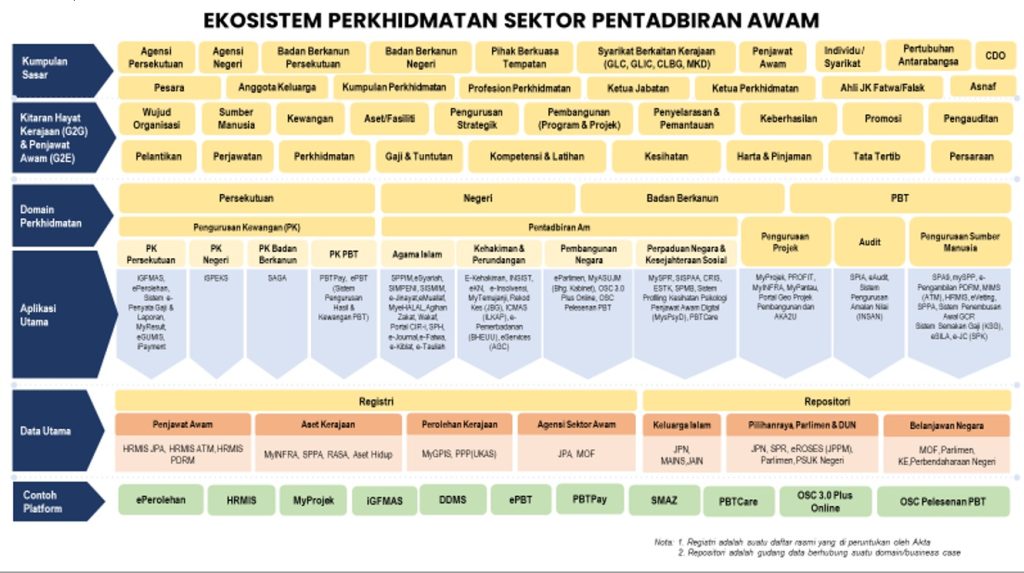
The Public Administration Sector Digitalization Overview focuses on the digitalization of government internal operations and administrative functions. The Public Administration Sector Service Ecosystem generally refers to the services provided by government ministries and departments as well as services provided by other entities under the control of a particular ministry/department to target groups. The form of service provided involves services provided by the government to other government organizations (government to government (G2G)) and government services to civil servants (government to employee (G2E)).
National Digital Department
Levels 1-6,
MKN Embassy Techzone Building
Block B, No. 3200
Jalan Teknokrat 2
63000 Cyberjaya, Sepang
Selangor Darul Ehsan
Tel: 603-8000 8000
Email: webmasterjdn@jdn.gov.my
Today’s Visitors: 245
Number of Visitors: 110190
Total Reach: 1092269
This site is best viewed using the latest version of Microsoft Edge & Google Chrome web browsers with a minimum resolution of 1366×768.